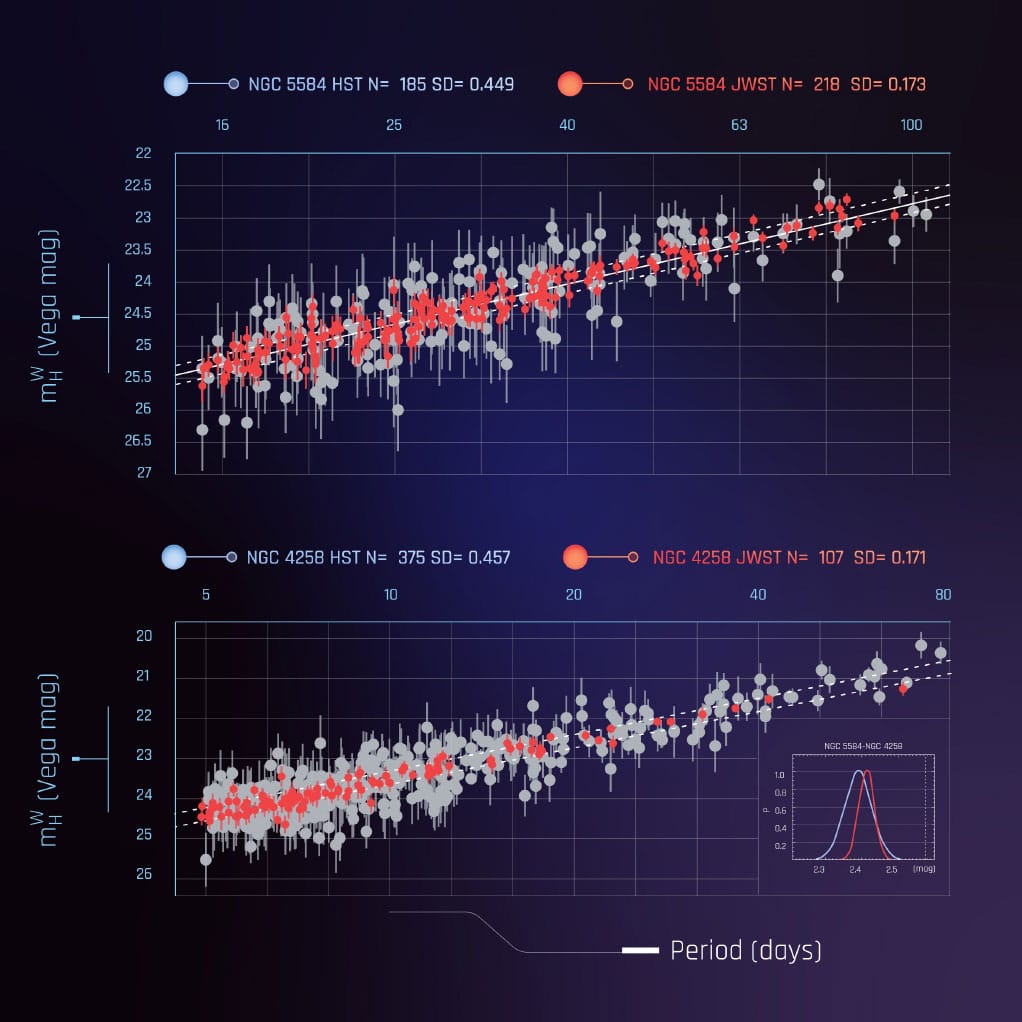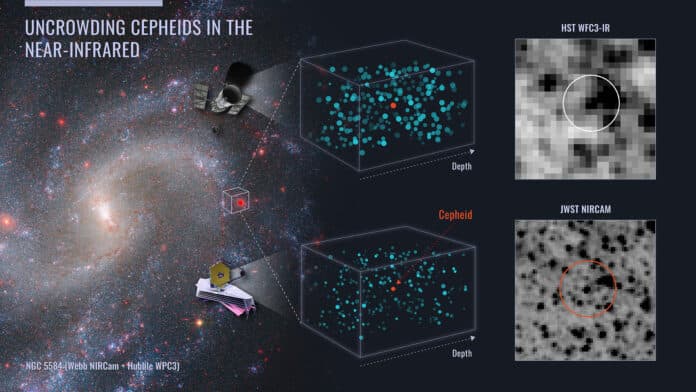Hubble Constant or H0: A unit of measurement that describes the Universe’s expansion rate. Over the last decade, an intriguing tension has emerged between the value of the Hubble constant (H0) measured directly from redshifts and distances, following its local definition and independent of models, and the same parameter inferred from the cosmological model, calibrated in the early Universe.
A solution is necessary since the “Hubble Tension” is highly significant across various local, independent distance indicators and experiments detecting the Cosmic Microwave Background (CMB). The James Webb Space Telescope (JWST) offers new tools for examining and improving some of the most compelling empirical data supporting this Tension.
Nobel Laureate Adam Riess from the Johns Hopkins University and the Space Telescope Science Institute presents his and his colleagues’ recent work using Webb observations to improve the precision of local measurements of the Hubble constant.
The Hubble constant, which indicates the rate at which the Universe expands, is the sign that cosmologists are looking for. The stars in far-off galaxies may contain this signature. The redshifts of the galaxies tell how much the Universe expanded throughout that time, which reveals the expansion rate, and the brightnesses of specific stars in those galaxies tell how far away they are and, therefore, for how long this light has been traveling to reach us.
Since more than a century ago, Cepheid variables, a class of extremely bright stars, have provided us with the most accurate distance measurements: They are supergiant stars with a brightness 100,000 times greater than the Sun.

They are the go-to instrument for determining the Hubble constant because they can measure the distance of galaxies that are 100 million light years or more away. Unfortunately, from our far-off vantage point, stars in galaxies are crammed together in a narrow area, and we frequently need more resolution to distinguish them from their line-of-sight neighbors.
Riess said, “A major justification for building the Hubble Space Telescope was to solve this problem. Before Hubble’s 1990 launch and its subsequent Cepheid measurements, the Universe’s expansion rate was so uncertain astronomers weren’t sure if the Universe had been expanding for 10 billion or 20 billion years. That’s because a faster expansion rate will lead to a younger age for the Universe, and a slower one will lead to an older age for the Universe.”
“Hubble has better visible-wavelength resolution than any ground-based telescope because it sits above the blurring effects of Earth’s atmosphere. As a result, it can identify individual Cepheid variables in galaxies that are more than a hundred million light-years away and measure the time interval over which they change their brightness.”
“However, we also must observe the Cepheids at the near-infrared part of the spectrum to see the light that passes unscathed through intervening dust. (Dust absorbs and scatters blue optical light, making distant objects look faint and fooling us into believing they are farther away than they are). Unfortunately, Hubble’s red-light vision is not as sharp as its blue, so the Cepheid starlight we see there is blended with other stars in its field of view. We can account for the average amount of blending statistically, the same way a doctor figures out your weight by subtracting the average weight of clothes from the scale reading, but doing so adds noise to the measurements. Some people’s clothes are heavier than others.”
However, one of the James Webb Space Telescope‘s superpowers is its ability to see clearly in the infrared. It can easily and with little blending isolate the Cepheid light from nearby stars thanks to its wide mirror and sensitive optics. With the General Observers program 1685, scientists gathered observations of Cepheids discovered by Hubble at two levels along the so-called cosmic distance ladder during the first year of Webb operations. To calibrate the actual luminosity of Cepheids, scientists must first see Cepheids in a galaxy with a known geometric distance. This galaxy’s name for the program is NGC 4258. The second phase is observing Cepheids in the host galaxies of recently active Type Ia supernovae.
Riess said, “We recently got our first Webb measurements from steps one and two, which allows us to complete the distance ladder and compare to the previous measurements with Hubble (see figure). Webb’s measurements have dramatically cut the noise in the Cepheid measurements due to the observatory’s resolution at near-infrared wavelengths. This kind of improvement is the stuff astronomers dream of! We observed more than 320 Cepheids across the first two steps. We confirmed that the earlier Hubble Space Telescope measurements were accurate, albeit noisier. We have also observed four more supernova hosts with Webb, and we see a similar result for the whole sample.”
“What the results still do not explain is why the Universe appears to be expanding so fast! We can predict the Universe’s expansion rate by observing its baby picture and the cosmic microwave background, then employ our best model of how it grows over time to tell us how fast the Universe should be expanding today. The fact that the present measure of the expansion rate significantly exceeds the prediction is a decade-long problem called “The Hubble Tension.” The most exciting possibility is that the Tension is a clue about something we are missing in our understanding of the cosmos.”
It might point to unusual dark energy or matter, a change in how we think about gravity, or a special particle or field. Repeating the measurements with higher accuracy is crucial because the most common explanation would be many measurement mistakes working together (astronomers have ruled out a single error by utilizing independent stages). The Webb observations provide the strongest proof that systematic mistakes in Hubble’s Cepheid photometry do not significantly affect the current Hubble Tension, with Webb verifying the Hubble measurements. The more intriguing alternatives continue to be a possibility, and the mystery surrounding the Tension grows.
Journal Reference:
- Adam G. Riess, Gagandeep S. Anand, Wenlong Yuan, Stefano Casertano, Andrew Dolphin, Lucas M. Macri, Louise Breuval, Dan Scolnic, Marshall Perrin, Richard I. Anderson. Crowded No More: The Accuracy of the Hubble Constant Tested with High-Resolution Observations of Cepheids by JWST. The Astrophysical Journal. DOI: 10.48550/arXiv.2307.15806
